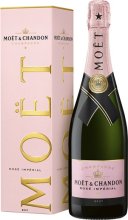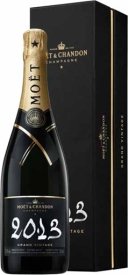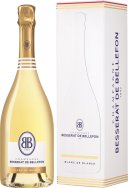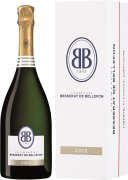Charles Heidsieck Brut Reserve Champagne Non-Vintage
With 40% of reserve wines, the Charles Heidsieck Brut Reserve Champagne offers complexity, voluptuous on the nose with notes of freshly baked brioche and the richness of roasted coffee beans. This is a deliciously sophisticated wine that finishes dry with a velvet texture, depth and long-lasting bubbles on the palate.
Moet & Chandon Rose Brut Non-Vintage
Looking for a special French Champagne to celebrate with? Moet has always crafted their NV Rose as a very popular, fleshy and flavoursome style. This Champagne is fully-bodied & zestful, wild strawberries, raspberries and cherries fill the palate and finishes with a soft freshness.
Moet & Chandon Vintage Champagne
The Grand Dame of Moet & Chandon the Vintage has spent years in the cellars to emerge as a star of the Champagne line. It's best to just pop the cork and fall in love all over again this Valentines Day.
Piper Heidsieck Rose Sauvage Non-Vintage
The deep, blushed rouge of this firm, well-structured, mouth-filling vinous Rose is underpinned by a powerful bouquet of plums and blackberries, and the rich flavours of forest fruits, pomegranate and raspberries. Regis Camus, International Wine Challenge Sparkling Winemaker of the Year 2004, 2007, 2008, 2009, 2010, 2011, 2012.
Veuve Clicquot Ponsardin Vintage
Veuve Clicquot has been producing fine quality Champagne since it was founded in 1772. In 1810, Madame Clicquot broke new ground by creating the first vintage Champagne, made of grapes from one single harvest. Veuve's non vintage is consistently rated in the top handful of NV Champagnes and delivers a powerful bubbly with a rich mouthfeel. The Ponsardin vintage is elegant with generous freshness and the Pinot Noir lends body to a very lively wine. On the palate there's layers of floral and fruity complexity that flows into a remarkably long and powerful finish.
Perrier-Jouët Blanc De Blanc Non-Vintage
Pale gold with hints of green, PerrierJouët Blanc de Blancs awakens the senses with enticing aromas of hedgerow flowers elderberry, acacia and honeysuckle and tangy citrus. On the palate, its mineral freshness lingers into a surprisingly smooth, mellow finish, which adds to the charm of this delightfully lively, luminous champagne.
Besserat De Bellefon Champagne Cuvee Rose
The house of Besserat de Bellefon was founded in 1843 near Ay in Champagne, and is now based in Epernay. The hallmark of the house is the lower than normal pressure that the wine is kept at under cork. This lower than normal pressure does not reduce the effervescence, but softens it, allowing the wine to partner better with food. Aspect: Soft rose with fine clear beads Bouquet: Red berries, hawthorn, the verve of springtime Palate: Wild strawberries, refreshing, seductive Assemblage : Chardonnay, Pinot Noir, Pinot Meunier
Besserat De Bellefon Champagne Blanc de Blancs Grand Cru
The house of Besserat de Bellefon was founded in 1843 near Ay in Champagne, and is now based in Epernay. The hallmark of the house is the lower than normal pressure that the wine is kept at under cork. This lower than normal pressure does not reduce the effervescence, but softens it, allowing the wine to partner better with food. The Blanc de Blancs - delicate and subtle citrus displaying a pure form of elegance. Aspect: Vivid, yellow, pure, brilliant Bouquet: Airy, acacia blossom, sea brine Palate: Tense, chalky, chiselled, vital, precise Assemblage : Chardonnay
Besserat De Bellefon Champagne Vintage
The house of Besserat de Bellefon was founded in 1843 near Ay in Champagne, and is now based in Epernay. The hallmark of the house is the lower than normal pressure that the wine is kept at under cork. This lower than normal pressure does not reduce the effervescence, but softens it, allowing the wine to partner better with food. Aspect: Deep, intense yellow Bouquet: Citrus, confits, honey, sweet spice, panettone, praline Palate: Generous freshness, opulence, purity, natural, exceptional Assemblage : Chardonnay, Pinot Noir, Pinot Meunier.
Billecart-Salmon Vintage Brut
Billecart Salmon is one of the most renowned champagne houses. The dedication to detail and quality sets this producer apart. The blend of 40% Pinot Noir, 33% Chardonnay and 27% Pinot Meunier is aged on lees for an impressive nine years and finished with a dosage of 2g/L, offering an extra dry finish.










